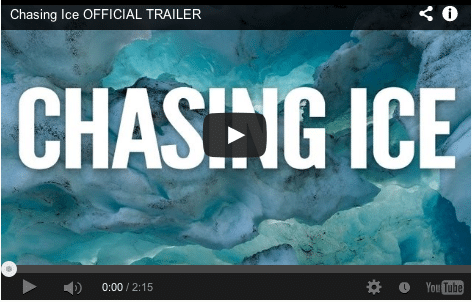
Jame Balog: Extreme Ice Survey. Photo courtesy of AGU Fall Meeting
The trouble with climate change is that it doesn’t mean much to most folks. Is our planet warming naturally, or is humankind being less kind to mother Earth than we should be? We typically approach these stories with stats and facts, when, as the following documentary proves, pictures are worth a 1,000 words to help us comprehend the impact of global warming.
Last night, I watched the most compelling documentary yet about the effects of climate change (man-made or not) called Chasing Ice. acclaimed environmental photographer, James Balog’s, placed dozens of time-lapse cameras around glaciers in the Arctic to capture their retreat. The individual images are pieced together together to document an alarming loss of ice.
But First the Data
Overlay his innovative visual essay with data from ice core samples, which are a frozen record of the Earth’s carbon dioxide content in the atmosphere and relative planet temperature over millennia, and you experience a documentary that shows us the impacts of a warming planet. What was especially pronounced to me in the segment about the ice core data is that our planet temperature naturally fluctuates, which is evident by the graph. Notice that, over that past 400,000 years, carbon dioxide never naturally elevated to more than 280 parts-per-million. When it increased, so did the temperature. The correlation between the two is obvious.
This data underscores that our planet is a living, breathing organism with natural changes in temperature over time, just like our own bodies. Now take this healthy organism and introduce it to smoking by burning fossils fuels beginning with the industrial age. Just like the tar and nicotine that pollutes a smoker’s body with every puff, we’re spewing carbon dioxide and other toxins into the ecosystem in the same manner. In addition, we are reducing the planet’s CO2-scrubbing ability by pruning its lungs through deforestation.
Now look at where we are relative to carbon dioxide, a so-called “greenhouse gas” in our atmosphere. We’re currently at 380 parts-per-million and climbing; nearly twice what occurs naturally. In the past 100 years, the temperature of the Earth has gone up 1.3 fahrenheit. Those who don’t think we’re having an impact on global warming should take 75 minutes and watch this film.
Turning Data into Drama
Now let’s witness how all of this plays out in a photos captured from the Extreme Ice Survey.
Most climate change experts come at the story of sustainability with lots of technical data and jargon that people just don’t understand. The data is important. It informs the story. But it is not the story. Balog has it right.
“Most of the time, art and science stare at each other over the gulf of mutual incomprehension. There is great confusion when the two look at each other. Art, of course, looks at the world through the psyche, the emotions, the unconsciousness at times, and of course the esthetic. Science tends to look at the world through the rational, the quantitative, things that can be measured and described. It gives art a terrific context for understanding.”
Balog’s Extreme Ice Survey, which is the story of sustainability behind the documentary, is dedicated to merging art and science to help us understand nature, and humanity’s relationship to nature. His TEDTalk on the project, and its startling findings, is also well worth a view.
When it comes to storytelling about sustainability, remember that showing is often more compelling than telling.













at 8:12 am
If you can reach people’s emotions through good storytelling, you could sell them anything, but what if the message isn’t true?
Those who believe the anthropogenic global warming movement is an attempt at social engineering based on the false premise that humans can control the weather and climate, receive different conclusions from your posting.
There is nothing alarming about ice melting – it has happened many times over the history of Earth, and ice will continue to recede and grow many times into the future, with our without humans.
The science isn’t settled on the correlation between temperature and CO2. You believe temperature always follows CO2, but there is no proof. Look at your own chart – recent levels of CO2 are shown to be abnormally high, but the temperature has flat-lined for years now. Why doesn’t this portion of the curve cause you to conclude CO2 may follow naturally occurring changes in temperature?
Don’t you question why all the dire predictions from a few years ago haven’t come true?
“Melting Arctic Sea Ice won’t break records” August 26, 2013
“Peru Declares State of Emergency in Puno as Temperatures Drop” August 28, 2013
“Polar bear population reaches its limits”, June 13, 2013
“Zero hurricanes at midway point, but threat remains for busy Atlantic hurricane season”, September 3, 2013
“New Theory for Why Antarctic Sea Ice Is Growing”, March 29, 2013
“Alaska already sees -10 C temperatures”, September 2, 2013
“GLOBAL WARMING EXPEDITION FOILED BY ICE”, AUGUST 31, 2013
at 5:44 am
All excellent points above, Pat. If you haven’t seen the movie Chasing Ice, I highly recommend it, if for nothing more than the human interest story of what Balog went through to capture the photos. The images are spectacular. You being an outdoor adventurist/enthusiast will particularly like to documentary.
at 7:51 am
Last summer we took the kids to see the Grand Canyon, Bryce, Zion, etc. While in Springdale, we visited a gallery where a nice lady greeted us and immediately launched into an obviously often told story about their famous photographer named “Fatali”. It was really quite the tale.
If she mentioned Fatali once, it had to have been fifty times. I got the sense the stories were meant to justify the high prices they were asking for pictures taken just down the highway in Zion.
Just as I had heard enough, the screen door in the back creaked open and in walked an unshaven guy, looked like he just mowed the backyard, and he’s snacking on a bologna sandwich.
He introduces himself to me as Mike. Turns out it was Mike Fatali, and the lady spinning her story was his wife.
I felt like I was being slimed by this lady making her husband out to be larger than life.
It’s my sense that James Balog is working out of the same manual. He’s taken cool footage and manipulated his storytelling for a particular audience. You know the exact same footage could accompany a story telling the opposite.
I’d have a hard time sitting through the screening knowing this guy conned my old buddy Park into thinking he is responsible for melting glaciers because he exhales CO2 .
at 11:30 am
It’s really worth a watch, Pat. I think you will enjoy it on several levels. Then I would love to hear your thoughts. Thanks.